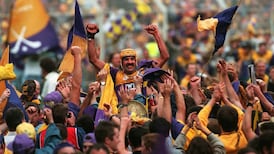I was working with TG4 in Semple Stadium on the last Sunday in March this year. Cork and Tipperary were in opposition in the league quarter-final. As is the usual pre-game format, the two analysts are on the sideline under the new stand with able presenter Micheál Ó Dómhnaill.
After the national anthem, the analyst doing the co-commentary heads down the sideline in all his finery, across behind the goal, halfway up the other sideline, up the steps of the old stand, up on to the walkway to the broadcast area. It’s a bit of a trek.
On this particular occasion I was to make the odyssey. As I passed behind the goal Cork goalkeeper Anthony Nash was picking the ball out of the net and muttering words, sometimes referred to as soldiers' words. By the time I made it to the broadcast area Tipperary had added on a few points.
In fact eight minutes into the game they had 2-4 on the scoreboard and Cork had yet to register. So there we had it, concrete evidence of the gulf in standard between Division One and Two. Cork had stumbled their way at the lower level while Tipperary didn’t perform much better up among the top teams but it had to be an advantage playing in the top level we thought.
There wasn’t much time for development of that particular theory because Cork did all the scoring in the next number of minutes and went in at half-time leading in a game which Tipperary eventually won on a score line of 3-25 to 4-19. Shootout is a word that springs to mind. Cork played in several games last year that could be similarly classed.
Prolific play
The previous year the same sides opened the 2012 league on a really cold night in Páirc Uí Rinn when Cork went on a point-scoring spree, leading by 14 points to two at half-time and adding 12 more to that in the second half.
So what are the chances of a high-scoring spectacle in the wide expanses of Croke Park this Sunday? Every, I’d say.
At this stage in both teams’ development under their respective managements one would assume that they have a fair idea as to their best 20 available players. Both teams have sets of what might be described as quicksilver forwards. On any given day both of these forward lines have the ability to be almost unmark able.
On both sides there are questions about the make up of the back lines.
I don't think that Damien Calahane has enough hurling for a wing-half back. He's a full back if he's to start. Mark Ellis at six is meeting the best in the business in Bonner Maher.
On the Tipp side there’s a debate again on who will play at full and centre back. There’s also a discussion as to who are the best players in those positions.
Pádraic Maher has seen a fair bit of time at three this year but it has to be argued that he is much better, more effective and more influential further out the field.
Or really is it important any more to have a commanding three and six ? Do all the backs have to be versatile enough to play in any position or indeed can we make the same assumption of the forwards ?
I went to the two football games in Croke Park last Saturday night and saw a full back, and an opposition corner back, scoring points and the marquee forward on one of the teams failing to score.
On Sunday I also saw Colin Fennelly making a very telling block and flick back on his own goal line half way through the second half. A high-octane work ethic is mandatory for all the outfield players in today's game.
Constant evolution
Hurling is in a continual state of evolution. The players of the distant and, indeed , near past would not cope with the speed of the game in its present state of dress. The present players would struggle with the ruggedness of goalmouth exchanges or ground hurling prowess of the latter-day hurlers.
As the game is presently played, versatility is a prerequisite as is speed of movement, thought and execution. Strength and power are also paramount.
This all means that as far as Sunday is concerned, having the best available, in form players, physically and mentally fit players ready for battle, is key.
Where they are picked doesn’t really matter. As long as they understand the game plan and are aware of the mice and men variation then there’s a chance that they’ll endeavour to play to their potential.
The bookmakers can’t decide who is going to win. The pundits are divided. The loyal followers of both counties are biased and can’t be relied upon for a pragmatic prediction.
So where will this game be won and lost? It will probably be a high-scoring match. So what conclusion can we draw from that where the back lines are concerned?
Very simply that the backs that concede the least will be on the team that will win the game.
That sounds a bit obvious doesn’t it.
The bottom line as far as I’m concerned is that I expect both sets of forwards to put up biggish scores and the back line that limits best will be on the winning team.












